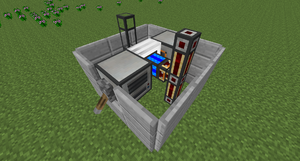ON THIS WIKI
Combustion Engine
| Combustion Engine | |
|---|---|

| |
|
| |
| Name | Combustion Engine |
| Source Mod | BuildCraft |
| ID Name | BuildCraft|Energy:engineBlock:2
|
| Type | Block |
| Stackable | Yes (64) |
| Blast Resistance | 25.0 |
| Hardness | 5.0 |
| Solid | Yes |
| Transparent | Yes |
| Affected by Gravity | No |
| Emits Light | No |
| Flammable | No |
| Required Tool | |
Combustion Engines are the third tier of Engine, and the most powerful in BuildCraft itself, although some engines in other mods surpass them. They are crafted from iron, making them the most expensive of the BuildCraft engines. Combustion engines draw full stacks when used on a Wooden Transport Pipes. They are designed to power machines that require a lot of energy, such as the Quarry.
To use a combustion engine you must first fuel it with Lava, Biofuel, Oil, Traincraft Diesel (which is the same as Oil), Traincraft Refined Fuel or Fuel and also keep its cooling tanks full of water. Without water the engine will quickly overheat, so it's advised to have an infinite water supply for the combustion engine to prevent explosions. It provides a clear warning when it is overheating: The combustion engine will ONLY become orange or red when there is no water left. While water is present the engine will heat up to 4,900.3 degrees Celsius on oil, 4,500.5 degrees Celsius on biofuel and 4,900.6 degrees Celsius on fuel. The explosion of a combustion engine occurs when its temperature reaches 10,000 °C and is large enough to break 2 layers of stone.
Water consumption can amount up to 1 bucket per second. For every bucket of refined oil a combustion engine will use up to 5000 mB of water.
This engine won't cool down if the redstone signal is on even if it doesn't have fuel. When switching off the engine, it will take several minutes for it to cool back down. The engine will only start again after being 30 seconds at 0 °C. With proper design, Gates can be used to automatically switch off the engine if it reaches the orange stage providing a failsafe in case the water supply fails.
The table below shows average power production for each fuel type. The engine only produces power during the stage of the animation in which it is retracting its arm, so, e.g., when running on Biofuel and warmed up to green it will generate 10 MJ/t for 10 ticks, then 0 MJ/t for 10 ticks. This generally does not matter, but needs to be taken into account to avoid wasting energy when buffering the output of a large number of engines with Redstone Energy Cells, which can accept input at a maximum of 100 MJ/t.
In „Supercraft” you can only use fuel to power the combustion engine.
| Fuel | Power | Ticks | Total MJ |
|---|---|---|---|
| Lava | 1 MJ/t | 20,000 | 20,000 |
| Oil | 3 MJ/t | 20,000 | 60,000 |
| Biofuel | 5 MJ/t | 40,000 | 200,000 |
| BioFuel | 4 MJ/t | ? | ? |
| Fuel | 6 MJ/t | 100,000 | 600,000 |
Modpacks using Minecraft 1.6.x+:
| Fuel | Power | Ticks | Total MJ |
|---|---|---|---|
| Lava | Not Supported | 0 | 0 |
| Oil | 3 MJ/t | 5,000 | 15,000 |
| Diesel | 3 MJ/t | 5,000 | 15,000 |
| Biofuel | 4 MJ/t | 15,000 | 60,000 |
| Fuel | 6 MJ/t | 25,000 | 150,000 |
Contents
Recipe[edit]
Feed The Beast Infinity Evolved Expert Mode[edit]
Engine Configurations[edit]
Supply Lines[edit]
Each engine needs three inputs and an output:
Depending on how the fuel, water, and power are transported, the Redstone signal may be able to come from a Gate placed on a Fluid Pipe or Kinesis Pipes transporting liquid or power. However, if Liquiduct is used for both liquids and Redstone Energy Conduit is used for power, the Redstone signal will have to occupy a separate block, for a total of 4 blocks neighboring the Combustion Engine occupied by supply, signaling and output lines. The Redstone signal can of course still use Gates for more compact logic and state detection than would be possible with Redstone Dust; the pipes carrying the Gates and Pipe Wires simply won't serve a double function.
For small setups, Fluid Pipes and Kinesis Pipes will suffice. As an engine room grows, the first obstacle reached is generally the water supply, as a Combustion Engine at its maximum stable temperature consumes a very large quantity of water. If the engines are drawing water from a tank, Wooden Fluid Pipe are necessary and will be a bottleneck, providing only 1 Bucket of water per second. Multiple Wooden Fluid Pipes outputting into a higher-capacity Golden Fluid Pipe should be a feasible solution, but will the liquid from one wooden pipe will have a tendency to go through the golden pipe and into another wooden pipe, so that they limit one another's output capacity. Liquiducts have an advantage, being able to pull two buckets per second and put it into a pipe system that does not suffer from this backflow issue.
In older versions of Buildcraft (up to BuildCraft 3), conductive pipes were used instead of kinesis pipes. They could explode under certain conditions, notably the creation of loops in the system, which allowed the power to build up in the pipes without ever reaching its destination. Kinesis pipes will just stop accepting more power if they're already at their limit, and loops are therefore completely safe.
| Configuration | Layout |
|---|---|
| Cross-section of an example setup with Redstone Energy Conduits. The 4 water blocks around the Aqueous Accumulators have been removed for clarity. Each engine can be activated separately. | |
| This configuration requires conduit as it does not leave room for the necessary Wooden Kinesis Pipes to draw power from all the engines. It has the advantage that each row of engines can be turned on and off separately, and the disadvantage that it is difficult to fit multiple double buffers (see below) at the end of a stack. |
Legend: [R]edstone signal [W]ater pipe [F]uel pipe [E]ngine [C]onduit |
| This has the advantages that Kinesis Pipes can be used and that it's easier to fit buffers on the end, with the disadvantage that the whole stack of engines shares a control signal. |
Legend: [R]edstone signal [W]ater pipe [F]uel pipe [E]ngine [C]onduit |
Output Buffering[edit]
When building a large engine configuration, it may be desirable to have an excess of energy available to meet variable demand, or the engine room may be built before the machines that will use the power. It is possible to use manual control to switch on the number of engines that are desired at any given moment, but it is also possible to build a regulator system that buffers the power output of the engines, provides the power needed at any given moment, and shuts engines off when they are not being used in order to conserve fuel.
The key components in such a system are Redstone Energy Cells and Gates. The idea is to buffer the output of the engines in the cell, with machines drawing from the buffer rather than directly from the engines. Then a Gate can detect when the buffer is empty and send a signal to switch the engines on, and detect when the buffer is full and send a signal to switch the engines off; a second Gate can latch the "On" signal, effectively remembering that the buffer is charging, and reset the latch on the "Off" signal to allow the buffer to discharge.
Since a Redstone Energy Cell can accept up to 100 MJ/t in and send up to 100 MJ/t out, one cell should be capable of buffering the output of 20 Combustion Engines running on Biofuel or 16 running on Fuel. There are two problems with this:
- Buffer overflow: Redstone Energy Cells do not reliably send a Full Energy signal to nearby Gates when they are full; in particular, as long as power is being drawn from them, they sometimes stay just below capacity even if supply is greater than demand.
- Variable power: Engines do not produce a consistent flow of, e.g., 5 MJ/t. Rather, when running on Biofuel, an engine will produce 10 MJ/t for a time, then 0 MJ/t for a time, with the switching frequency depending on the temperature of the engine.
The first issue is solved using a double buffer setup and a redstone clock. The cell will reliably send a Full Energy signal if power is not constantly being drawn from it and continues to be supplied. By briefly interrupting the output of the energy cell, it is possible to detect, at regular intervals, whether or not the buffer is full. Since cells can be turned on and off with redstone, a clock can provide this interrupting signal.
However, to avoid interruptions in machine operation, it is desirable to make the clock send as brief and infrequent signals as possible. Energy will continue to be produced in between clock signals, and to avoid wasting this energy if the output buffer is full, a secondary buffer is needed. Machines draw from the primary buffer, which draws from the secondary buffer. The primary buffer is occasionally switched off if the engines are running, and the secondary buffer catches the overflow between when the primary buffer fills up and when the next clock pulse comes in.
The second issue is solved using twice as many parallel secondary buffers as primary buffers. When the engines are producing, if they happen to all be synchronized (which cannot be easily controlled), then 20 engines running on Biofuel may produce a peak power of 200 MJ/t, which is the maximum input of two energy cells in parallel. Since the secondary buffers can smooth out the power curve, the primary buffer only needs to be capable of handling the average, and not the peak power.
External Links[edit]
- Upcoming changes to Combustion engine in BC 4.1.0
- Video by CJ about the changes to combustion engine in BC 4.1.0
Video[edit]
| ||||||||||||||||||||||||||||||||||||||||||||||||||||||||||||||
 Twitter Feed
Twitter Feed
Warning: file_get_contents(/srv/common/): failed to open stream: No such file or directory in /var/www/html/skins/MMWiki/SkinMMWiki.php on line 392



 Discussion
Discussion

